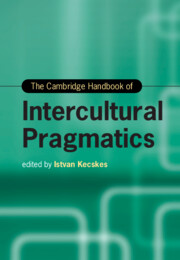Book contents
- The Cambridge Handbook of Intercultural Pragmatics
- Cambridge Handbooks in Language and Linguistics
- The Cambridge Handbook of Intercultural Pragmatics
- Copyright page
- Contents
- Figures
- Tables
- Acknowledgment
- Contributors
- Introduction The Rise of Intercultural Pragmatics
- Part I Theoretical Foundation
- Part II Key Issues in Intercultural Pragmatics Research
- 5 The Cultural, Contextual, and Computational Dimensions of Common Ground
- 6 Role of Context
- 7 (Mis/Non)Understanding in Intercultural Interactions
- 8 Creativity and Idiomaticity in Intercultural Interactions
- 9 Metaphors in Intercultural Communication
- 10 Common Ground in Linguistic Theory and Internet Pragmatics: Forms of Dynamic Multicultural Interaction
- 11 Vague Language from a Pragmatic Perspective
- 12 Humor in Intercultural Interactions
- 13 Emotion in Intercultural Interactions
- 14 Research Methods in Intercultural Pragmatics
- Part III Interface of Intercultural Pragmatics and Related Disciplines
- Part IV Intercultural Pragmatics in Different Types of Communication
- Part V Language Learning
- Index
- References
10 - Common Ground in Linguistic Theory and Internet Pragmatics: Forms of Dynamic Multicultural Interaction
from Part II - Key Issues in Intercultural Pragmatics Research
Published online by Cambridge University Press: 29 September 2022
- The Cambridge Handbook of Intercultural Pragmatics
- Cambridge Handbooks in Language and Linguistics
- The Cambridge Handbook of Intercultural Pragmatics
- Copyright page
- Contents
- Figures
- Tables
- Acknowledgment
- Contributors
- Introduction The Rise of Intercultural Pragmatics
- Part I Theoretical Foundation
- Part II Key Issues in Intercultural Pragmatics Research
- 5 The Cultural, Contextual, and Computational Dimensions of Common Ground
- 6 Role of Context
- 7 (Mis/Non)Understanding in Intercultural Interactions
- 8 Creativity and Idiomaticity in Intercultural Interactions
- 9 Metaphors in Intercultural Communication
- 10 Common Ground in Linguistic Theory and Internet Pragmatics: Forms of Dynamic Multicultural Interaction
- 11 Vague Language from a Pragmatic Perspective
- 12 Humor in Intercultural Interactions
- 13 Emotion in Intercultural Interactions
- 14 Research Methods in Intercultural Pragmatics
- Part III Interface of Intercultural Pragmatics and Related Disciplines
- Part IV Intercultural Pragmatics in Different Types of Communication
- Part V Language Learning
- Index
- References
Summary
The notion of common ground entails that prior to a conversation, mutually shared knowledge is available to interlocutors by virtue of the situational context or a shared cultural background. Within linguistic pragmatic theories, recipient design is a determining factor for cooperation in interaction. The socio-cognitive approach to communicative interaction acknowledges the importance of cooperation and common ground but maintains that interlocutors tend to adhere to their individual background knowledge and experience for production and comprehension. The shared knowledge base may therefore not be fully available prior to the exchange but, rather, established dynamically and interactively in the course of the conversation. Discussing internet memes, it will be shown that stable core common ground and dynamic emergent common ground are fundamental assets for the description of contemporary and future phenomena in digital communication. I will argue that internet memes represent a kind of communication where emergent common ground is aspired to rather than resorted to as an emergency solution when core common ground is lacking.
Keywords
- Type
- Chapter
- Information
- The Cambridge Handbook of Intercultural Pragmatics , pp. 245 - 273Publisher: Cambridge University PressPrint publication year: 2022
References
References
Websites
knowyourmeme.com: https://knowyourmeme.com
stayhipp.com: https://stayhipp.com/internet/memes/leonardo-dicaprio-laughing-django-unchained-memes/
- 1
- Cited by



